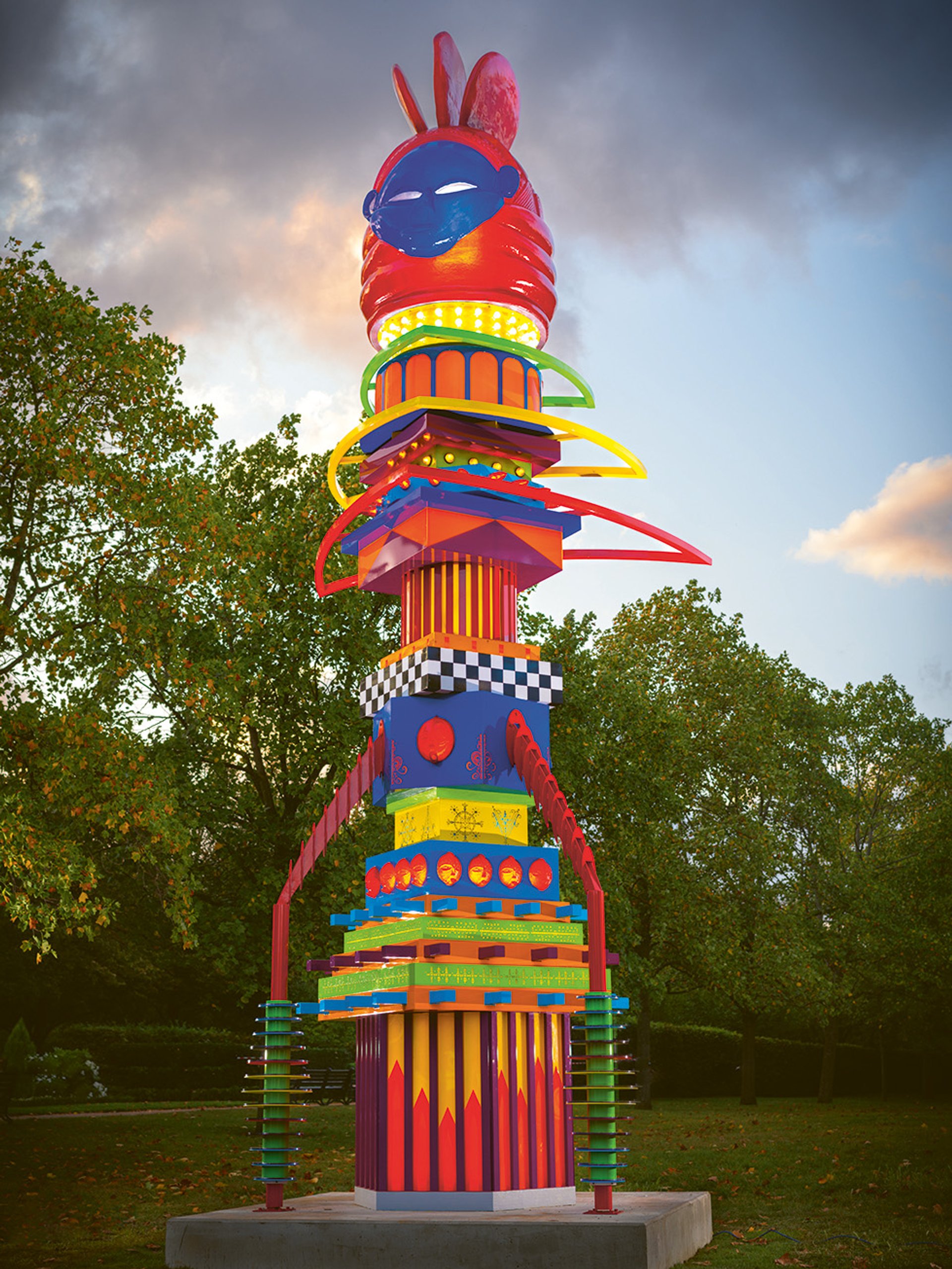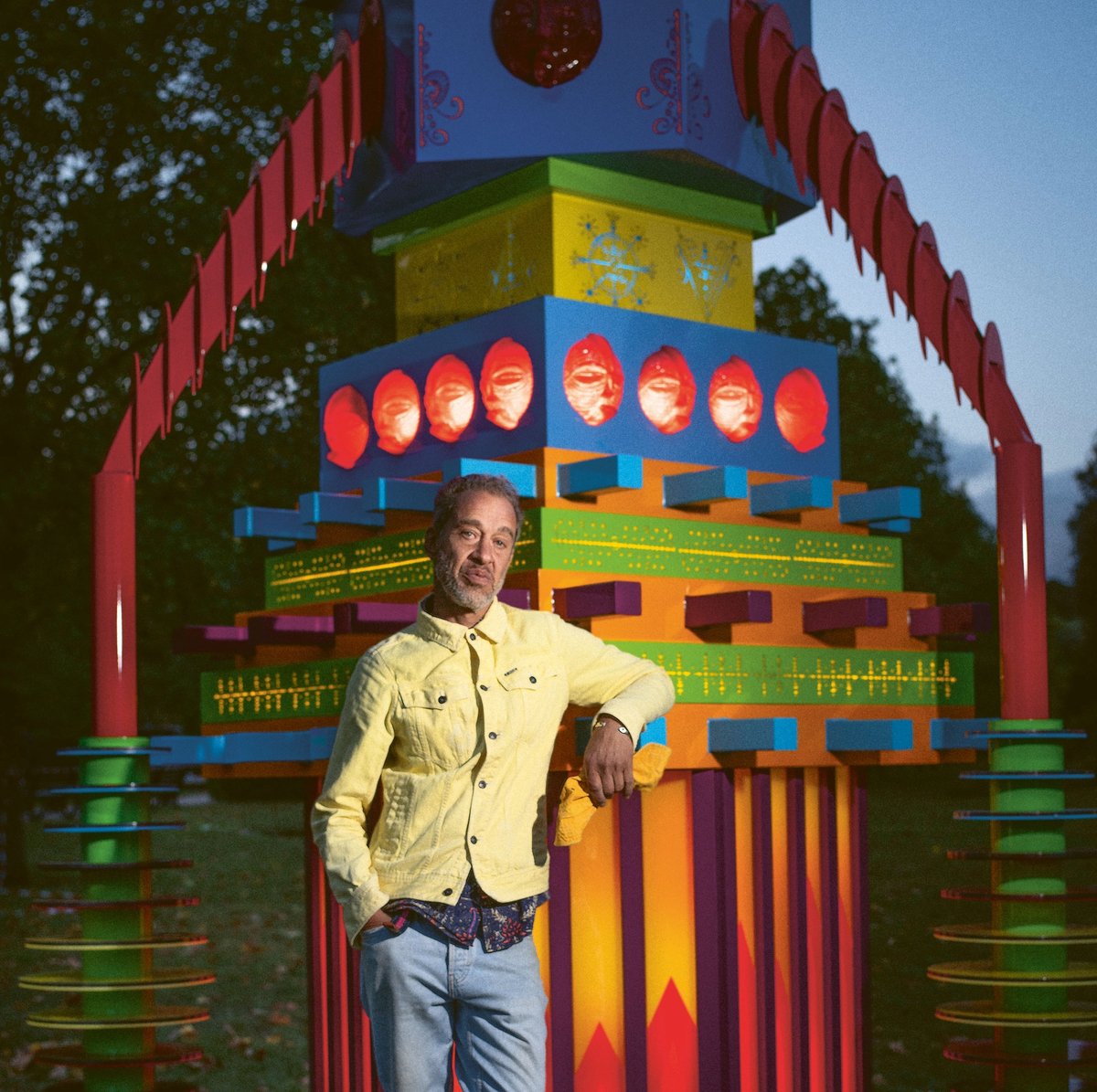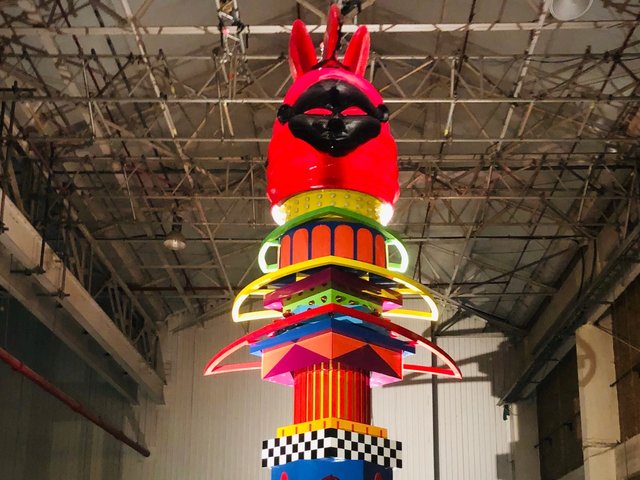Zak Ové is not an artist known for holding back. His two giant carnivalesque moko jumbie stilt-walker sculptures at present preside over the British Museum’s Africa Galleries, with another version in the permanent collection of the Art Gallery of Ontario. Over the past few years his crowd of 80 identically cast graphite figures—based on a wooden sculpture from Kenya and each standing at 2m high—have been lined up before Somerset House in London, Los Angeles County Museum of Art, San Francisco’s City Hall and the Yorkshire Sculpture Park. Now, the British-Trinidadian artist is showing his largest work yet, The Mothership Connection (2021), a massive, multi-coloured structure nearly 9m high, and a serious show-stopper in the Frieze Sculpture presentation in Regent’s Park.

The Mothership Connection, named after an album by Parliament and inspired in part by the BT Tower, was originally destined for a Hawaiian sculpture park Courtesy of Zak Ové and Gallery 1957
The Art Newspaper: Part-totem, part-robot, part-rocket, The Mothership Connection fuses African, Western and Pop-cultural references and lights up like a beacon. What’s the thinking behind this mash-up of eras and influences?
Zak Ové: I wanted to make a work about the diaspora of Africa that was not just tied to the continent itself but was also about how the Black community has contributed to Western modernity worldwide. The base is shaped like Mali’s famous Djenné mud mosque and the body has African masks and Haitian veve symbols, as well as elements from the columns you see in Masonic architecture and details from the Capitol Building. I’d been on a trip to Washington, DC and had become fascinated by all the Masonic architecture that is used as the face of white Western modernity and the glory of the Western world. But what was never discussed was how these historical monuments had been built by slaves and indentured labour; this was not referenced or recognised. So, I wanted to pay homage to the contribution of the Black community and to the invisible histories of these buildings.
Why did you choose a Mende helmet mask for the head?
The Mothership needed to be a mother in the feminine sense and these Mende masks are worn by the women of Sierra Leone to perform healing ceremonies. Within the whole structure of tribal identities and mask making, they are the only helmet masks to be worn exclusively by women, so they are all about female power and healing—and I also love that their design is so futuristic. In my work I’m interested in how new-world materials can take old-world traditions and [bring] them into the present moment—how a tradition can be pulled back from being antiquated and become exciting and vibrant through a new language of colour and materials. What was some dusty old piece of ebony wood in a museum becomes an 8ft helmet mask in see-through red and blue acrylic, lit up from within. It’s a translation of old-world culture into a future-world culture.
The sculpture’s title comes from a classic album by the group Parliament
I remember my father taking me to see George Clinton and Parliament at the Hammersmith Odeon in 1978, the year after Star Wars came out. When George entered the stage in a spaceship it blew me away; it gave me a reference I could dream of and it changed my world. For many Black artists of my generation, our heroes come from music because they were the first revolutionaries to get global recognition. It was really the first Black art form to go mainstream in that sense.
There’s also a sense of retro-futurism in the work; it has Cadillac fins and American car headlamps, and lights up like a juke box.
Yes, absolutely! I nicked the legs off Thunderbird 3 and Africanised them with some ankle bracelets! The BT Tower—or the Post Office Tower as it was then—was also influential in the development of the work. I’ve got such an imprint of it, having grown up in London in the 1970s not far from where The Mothership is now placed in Regent’s Park; and I love that now you can see both The Mothership and the tower at the same time.
It’s been quite a journey to get The Mothership Connection to Frieze. The work was originally commissioned for a sculpture park in Hawaii before Covid-19 put paid to that project, and it has been in storage ever since. How do you feel about it being on public view for the first time?
I was so nervous that it would never get seen, and when it first went up I’d never seen it in daylight before! I was so happy that all the colours worked so well. She’s beautiful, she’s graceful, she’s fierce and she’s funny. She’s proud and she’s resplendent and she owns the space. I think what’s really important to me is that the work is uplifting; I want any child to run up to it with a sense of elation and when you walk away for you to feel better about things.
In 2019 you curated Get Up, Stand Up Now, an exhibition at Somerset House celebrating 50 years of Black creativity in tribute to the life and work of your father, the film-maker and artist Horace Ové who sadly died last month. You also worked with him on his 1985 film about the Bhopal gas tragedy in India. How has his influence fed into your work?
It was Horace’s natural ability to question that is his legacy to me. He taught me to question and to speak up—not just for myself but for others who couldn’t—for injustice and equity, and not to worry if I made people uncomfortable around me while doing so. He showed me how to stand up to a situation and to make it count. With Horace, I felt like I’d been given the keys at an early age; I always felt involved in all his projects. The shebeens, the concerts, carnivals and clubs I was dragged to became my place of residence, and in many ways I fell in love with his practice. I also learned that the important thing is never to be shut down; Horace always thought it was important to tell the stories of not just the Black community but also of the white world he was living in. The idea that your eyes don’t only see you, they see everything, was so important to him and is to me. It has been really rewarding for me just after his death to be able to show my best work to date that really was inspired by him. What I want now is for his spirit to live on in the work that I do.
• Zac Ové’s The Mothership Connection is on show as part of Frieze Sculpture, Regent’s Park, until 29 October




